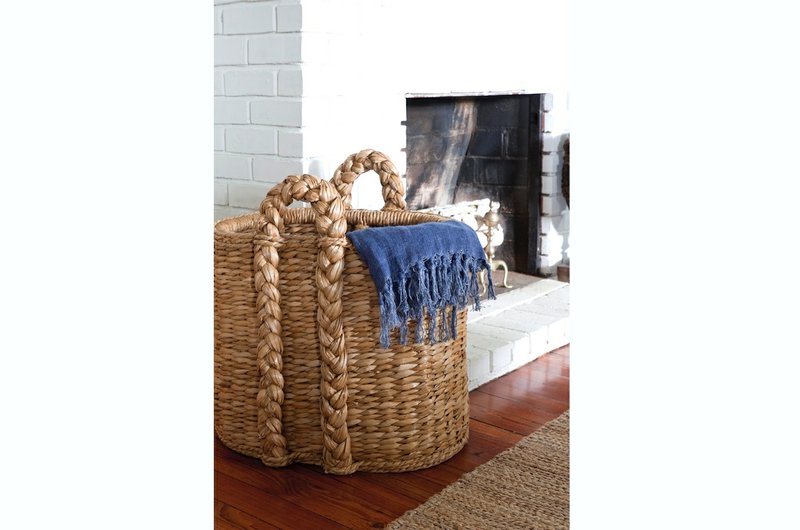Shame on me. I have been writing this home column now for 16+ years. Every. Single. Week. Over those years, I have written about some arguably pretty minor topics. Take, for instance, the color white, how to choose a yard boulder and how to throw away a computer. Somehow, while dwelling on all sorts of fascinating-no-point-is-too-small minutiae, I have neglected to write about a common domestic workhorse, an item most every home has, and has had since the dawn of humanity, an item most of us use. Every. Single. Day.
So today, as we approach the season of gratefulness, I am giving long-overdue homage to the humble, honorable basket.
An art form that started back when the earth was cooling, or, more accurately, pretty much as soon as people became people, according to experts in these sorts of things, baskets have transcended every age, culture and civilization.
As long as grasses and reeds have grown alongside people needing to gather stuff up, we've had baskets. Their weavers have rustled up whatever was plentiful and free — cattails, wheat, prairie grass, palm branches, water hyacinth, seagrass and plastic drinking straws — to fashion into everything from bassinettes and bowls to blanket bins and birdcages. They've woven containers tight enough to hold water and loose enough to catch fish. Like the wheel, baskets are hard to improve on. They just work.
Because their natural materials tend to break down after thousands of years, or a week outside in Florida, the oldest baskets we have date back only 10,000 or 12,000 years. Yet archaeological evidence shows that baskets began long before and predate pottery and The Beatles.
"Although baskets date back to ancient times, we still use them in the same ways," said Robyn Bailey, owner of Mainly Baskets, a 40-year-old Georgia-based company with an all-female-run factory in the Philippines, "to gather, transport and store." In the factory, women hand-weave mainly baskets (but also furniture) out of sustainable natural materials harvested in Southeast Asia, including rattan, water hyacinth and seagrass.
Intrigued by the history, and the quality of her company's baskets, I call Bailey. I start by extending a bushel of long-overdue basket appreciation. "I've been taking baskets for granted all these years," I confess during our call. "But when I really stop to look at them, I realize they check all my home design boxes. They're beautiful, functional, textural, sculptural, versatile and historical."
Of course, she completely agrees and probably wonders in what prehistoric cave I've been living in that I just now noticed.
Bailey tells me her fondness for baskets began years ago when her husband became the CPA for Mainly Baskets. As she learned about the product and the basket-making process, "it was like this instant crush." In 2006, the original owner stepped down, and Bailey and her husband bought the company. Fast forward 10 years, and Bailey, who'd been working in restaurant marketing for 30 years, came home one day and told her husband she'd had enough of corporate America. She quit her job and in 2016 put all her eggs into Mainly Baskets. Sales have climbed steadily since.
It's not an easy business. Longaberger, a well-known basket company that started in Ohio in 1973, and grew to a $1 billion company with 8,000 employees, went out of business last year. Longaberger baskets tend to be picnic size or smaller, while Mainly Baskets trend toward larger, more substantial baskets, Bailey said.
After exchanging more reasons to love baskets, I asked Bailey a few more questions so I could better appreciate this household mainstay:
Marni: Why should baskets be part of every home?
Bailey: Besides being beautiful and useful, baskets work with every decor style, whether rustic, country, traditional, ethnic or modern. They are multi-purpose, so can easily go from room to room, and are one of the easiest ways to give a room interest and dimension.
Marni: Baskets come at many price levels. How can you tell a well-made basket from a cheap one?
Bailey: Not every basket needs to last for decades. Some just need to deliver a batch of muffins. But if you want one that will last, give it the squeeze-and-twist test. It shouldn't smush. Pick the basket up. It should have some heft. Most of mine you can sit on.
Marni: Beyond the obvious uses — holding fruit, vegetables, bread, toys, magazines and Easter goodies — how else can decorators incorporate baskets at home?
Bailey: Use a basket for any items you need to corral, and anywhere you don't want your uglies to show. They can hold firewood, toiletries, remote controls, plants, toilet paper, mail, towels, laundry, shoes, socks and umbrellas. I put a big basket at the end of my sectional for throw blankets.
Marni: What's the difference between rattan and wicker?
Bailey: Rattan is a vine that grows on trees. It's harvested, so you don't chop down the tree; thus, it's renewable and sustainable. Because it is solid, rattan is stronger and lasts longer than bamboo, which is hollow. Wicker is not a material, but a weaving technique that uses rattan, as well as reed, willow or bamboo, to make wicker furniture and baskets.
Marni: What do you wish more home decorators knew about baskets?
Bailey: That large baskets can be statement pieces. Adding a beautifully proportioned, handsome basket to a room is like getting a piece of furniture.
Syndicated columnist Marni Jameson is the author of five home and lifestyle books, including Downsizing the Family Home — What to Save, What to Let Go
HomeStyle on 11/09/2019

